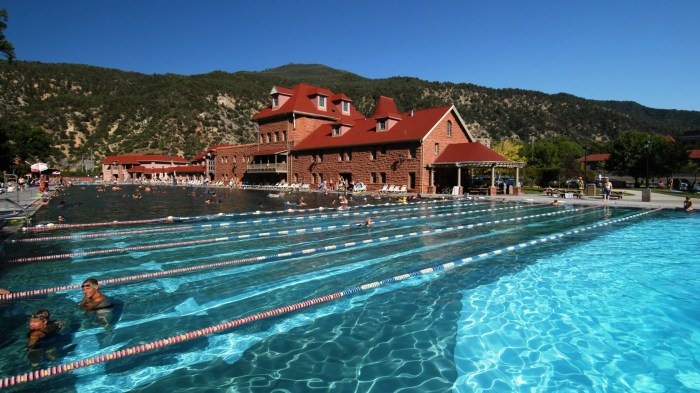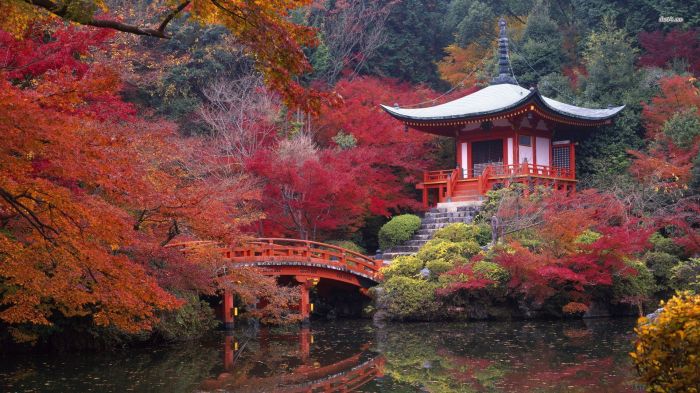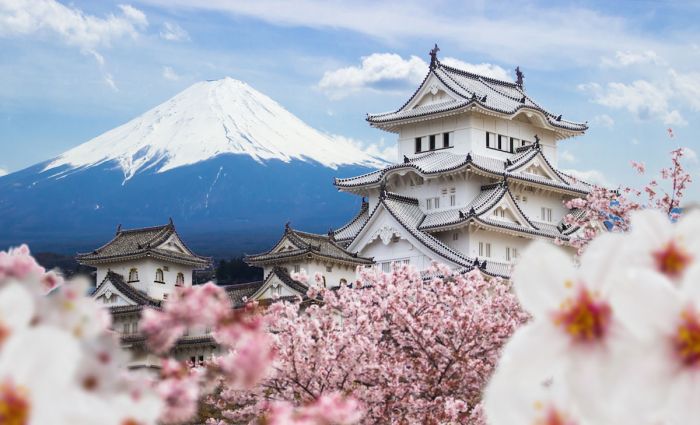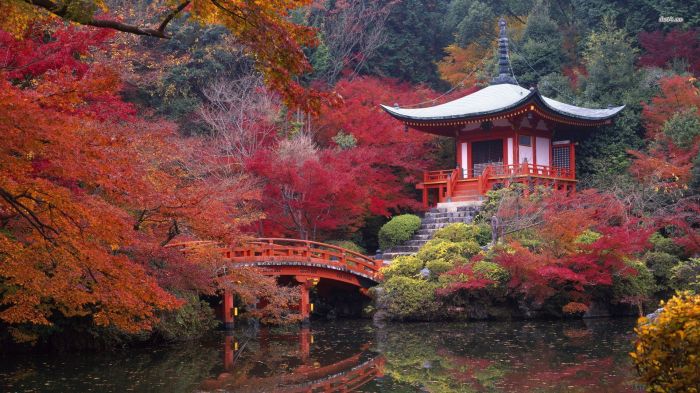Best hot springs in Colorado: Unveiling Colorado’s hidden gems, from natural pools to luxurious resorts, this guide delves into the best hot springs experiences. Discover the historical and cultural significance of these natural wonders, and explore the diverse range of mineral springs and their potential health benefits. Prepare to be amazed by the beauty and relaxation that awaits.
This comprehensive exploration of Colorado’s best hot springs will take you on a journey through stunning landscapes and unique experiences. We’ll explore the criteria for selecting the “best,” from accessibility and amenities to natural beauty and therapeutic qualities. Expect a deep dive into the top-rated destinations, their unique characteristics, and the geological origins of their hot water. We’ll also cover practical information, including accessibility, costs, and seasonal variations.
Introduction to Colorado Hot Springs
Colorado’s hot springs, a testament to the state’s geological wonders, hold a rich history intertwined with Native American traditions and early European settlements. These natural thermal pools, often infused with minerals, have attracted visitors for centuries, offering respite and rejuvenation. From the soothing warmth of natural pools to the luxurious amenities of resort hot springs, the state offers a diverse range of experiences tailored to every traveler’s preferences.The diverse range of experiences available, from rustic natural hot springs to lavish resorts, caters to a wide spectrum of interests.
The unique mineral content of these springs, ranging from calcium to sulfur, contributes to their therapeutic properties and attracts those seeking health benefits alongside relaxation. These springs, often discovered and utilized by indigenous communities long before European colonization, represent a profound cultural and historical legacy.
Historical and Cultural Significance
Colorado’s hot springs have been vital to the region’s history. Native American tribes have traditionally utilized these natural resources for healing and spiritual ceremonies, recognizing the therapeutic properties of the mineral-rich waters. European settlers, recognizing the potential for health and recreation, later established resorts and spas around these natural wonders. This historical interplay between indigenous and settler cultures contributes to the unique cultural landscape surrounding Colorado’s hot springs.
Diverse Hot Spring Experiences
Colorado’s hot springs offer a spectrum of experiences. Natural pools, often situated in scenic locations, provide a raw, immersive connection with nature. These pools often lack the amenities of modern resorts but retain the authenticity of the natural environment. Luxurious resorts, on the other hand, provide a more comprehensive experience, with amenities such as spas, lodging, and dining options, appealing to those seeking comfort and convenience.
Both options cater to distinct preferences, emphasizing the diverse choices available to visitors.
Types of Hot Springs and Potential Benefits
Colorado’s hot springs exhibit a range of mineral compositions. Mineral springs, rich in specific minerals like calcium, magnesium, or sulfur, are known for their potential therapeutic benefits. For example, sulfur-rich springs are often associated with relief from skin conditions. The unique composition of the mineral content influences the perceived benefits, emphasizing the importance of understanding the specific mineral profile of a particular spring.
Famous Hot Springs Locations
Several famous hot springs locations in Colorado attract visitors from around the world. These locations showcase the state’s natural beauty and the unique experiences available.
| Location | Type | Key Features |
|---|---|---|
| Glenwood Hot Springs | Natural Pool | Scenic mountain setting, historical significance, simple amenities. |
| Ouray Hot Springs | Resort | Luxurious accommodations, spa treatments, stunning mountain views. |
| Pagosa Springs | Mineral Springs | Known for healing properties, various pools with different mineral compositions. |
| Strawberry Park Hot Springs | Natural Pool | Secluded location, perfect for solitude, beautiful surroundings. |
Criteria for Selecting the “Best” Hot Springs
Choosing the “best” hot springs in Colorado is a deeply personal journey, as preferences vary greatly. Factors like the desired experience, the level of amenities, and the therapeutic benefits all play a role in shaping the ideal hot springs destination. Ultimately, the “best” hot spring for one person might be quite different from the “best” for another.A key consideration in selecting a hot spring is evaluating the various factors that contribute to a truly exceptional experience.
This encompasses not only the natural beauty and therapeutic qualities of the spring, but also its accessibility, amenities, and overall ambiance. Understanding these nuances is essential for making an informed decision that aligns with individual preferences and expectations.
Accessibility and Convenience
Location and ease of access are critical for a positive experience. A hot spring that is easily reachable by car or public transportation, with ample parking and clear directions, will undoubtedly enhance the overall experience. The proximity to lodging and other attractions can also greatly influence the decision-making process. Factors like travel time and potential traffic congestion are important considerations for a truly enjoyable trip.
Furthermore, accessibility for individuals with disabilities is a crucial aspect to evaluate, ensuring that the hot spring is inclusive and welcoming to all.
Amenities and Services
The presence of various amenities can significantly enhance a hot spring experience. Consider factors like the availability of lodging options, dining facilities, and recreational activities. A well-equipped hot spring with these amenities provides a complete and enjoyable experience, making it easier to fully immerse oneself in the destination. Pools with different temperature settings, saunas, and massage services are examples of amenities that contribute to a more comprehensive experience.
The quality and variety of these amenities should be carefully assessed.
Colorado’s hot springs are amazing, offering unique geothermal experiences. But if you’re looking for a different kind of soak, check out the incredible hotel pools in Florida. From luxurious resorts to charming boutique hotels, Florida offers a variety of options, perfect for a relaxing getaway. Ultimately, Colorado’s hot springs still reign supreme for their natural beauty and therapeutic benefits, and for a unique experience you can’t beat them.
hotel pools in florida are a great alternative, though!
Natural Beauty and Surroundings
The natural beauty surrounding a hot spring often plays a significant role in its appeal. A serene setting, lush vegetation, or breathtaking views can transform a simple hot spring experience into a truly memorable and rejuvenating escape. The presence of natural features, such as waterfalls, forests, or mountain vistas, can significantly elevate the ambiance and contribute to the overall experience.
Visual appeal and the integration of nature into the hot spring environment are important considerations.
Therapeutic Qualities
The therapeutic properties of a hot spring can be a key draw for many. Mineral content and temperature can vary significantly, impacting the potential therapeutic benefits. Researching the specific mineral composition and its potential health benefits can inform the decision-making process. The temperature of the water is a critical factor, as different temperatures can target different health needs.
User Reviews and Feedback
Understanding the experiences of others is invaluable when choosing a hot spring. Online reviews and user feedback provide a wealth of information regarding the amenities, services, and overall experience. Reading reviews from previous visitors offers valuable insights into the practical aspects of the hot spring, such as cleanliness, staff friendliness, and the overall atmosphere. It’s crucial to assess both positive and negative feedback, looking for recurring themes and patterns in the opinions shared by other users.
Essential Amenities for Choosing a Hot Spring
- Accessibility: Easy access via transportation, parking, and clear directions are essential.
- Lodging Options: Availability of lodging nearby enhances the experience.
- Dining Facilities: The presence of restaurants or cafes near the hot spring simplifies mealtimes.
- Recreational Activities: Options like hiking trails or nearby attractions make for a more comprehensive experience.
- Variety of Pools: Different temperature pools cater to various preferences and health needs.
- Saunas and Steam Rooms: These amenities offer additional relaxation and therapeutic benefits.
- Massage Services: Professional massages complement the relaxation experience.
- Cleanliness and Maintenance: A clean and well-maintained environment is essential for a comfortable experience.
Comparison of Selection Criteria
| Selection Criteria | Importance Level (1-5, 5 being highest) |
|---|---|
| Accessibility | 4 |
| Amenities | 4 |
| Natural Beauty | 3 |
| Therapeutic Qualities | 3 |
| User Reviews | 5 |
This table summarizes the importance levels assigned to each criterion. The importance level is a subjective measure reflecting the relative significance of each factor in the overall evaluation process. User reviews are considered highly important due to their ability to reflect the practical aspects of the hot spring experience.
Colorado’s hot springs are amazing, offering a perfect escape after a long day. Planning a trip to soak up the natural hot springs, though, often involves considering transportation options. If you’re looking to travel by train, checking out a guide like amtrak empire builder how to plan a train trip to the pacific northwest can help you navigate the process and find the perfect route for your hot springs getaway.
Ultimately, immersing yourself in the natural beauty of Colorado’s hot springs is a truly rewarding experience.
Top-Rated Hot Springs Destinations
Colorado’s hot springs offer a unique blend of relaxation and rejuvenation, drawing visitors from across the country. Beyond the soothing warmth, these natural wonders often boast captivating geological histories and therapeutic mineral compositions. Exploring these destinations provides an opportunity to connect with the state’s natural beauty and experience the healing properties that nature provides.
Top 5 Colorado Hot Springs
Colorado boasts a plethora of hot springs, each with its own unique charm and appeal. This selection focuses on five top-rated destinations, considering user reviews, expert opinions, and overall popularity. Factors such as accessibility, amenities, and the therapeutic qualities of the mineral-rich waters are considered.
- Strawberry Park Hot Springs: Nestled in the scenic Yampa Valley, Strawberry Park Hot Springs is renowned for its natural beauty and tranquil atmosphere. The springs are fed by the Yampa River, providing a constant flow of rejuvenating mineral-rich water. The spring’s gentle temperature and surrounding landscape make it a perfect retreat for relaxation and rejuvenation.
- Ouray Hot Springs: Situated in the breathtaking San Juan Mountains, Ouray Hot Springs offers a unique alpine experience. The springs are known for their mineral content, including sulfates and carbonates, which contribute to their therapeutic properties. The stunning mountain scenery and proximity to other outdoor activities make this a popular destination.
- Glenwood Hot Springs Resort: Located in the heart of the Colorado Rockies, this resort boasts a variety of hot springs pools and amenities. The springs’ mineral content, including magnesium and calcium, is believed to contribute to their therapeutic qualities. The resort’s proximity to Glenwood Springs and the surrounding hiking trails provide ample opportunities for exploring the region.
- Pagosa Springs Hot Springs Resort: The area is rich in mineral-rich springs. The springs are known for their high mineral content, particularly sulfate, that contribute to their therapeutic properties. The resort provides a comprehensive spa experience with various treatments and pools, making it an ideal destination for relaxation and rejuvenation.
- Cañon City Hot Springs: This location in southern Colorado offers a unique experience. The springs are fed by a unique geological formation, creating a natural wonder. The mineral content, particularly calcium and sodium, contributes to the therapeutic benefits of the springs. Its proximity to the Arkansas River provides a picturesque setting for a memorable stay.
Geological Origins of the Hot Springs
The geological formations responsible for the hot springs vary depending on the specific location. Deep within the Earth’s crust, geothermal activity heats groundwater. This heated water then rises to the surface through fault lines or porous rock formations, carrying dissolved minerals along the way. This process creates the hot springs we enjoy today. For example, the high mineral content in Ouray Hot Springs is due to the unique geological structure of the San Juan Mountains.
Therapeutic Benefits of Mineral Content
The unique mineral composition of each hot spring contributes to its therapeutic benefits. For instance, sulfur-rich springs are often touted for their potential to ease arthritis pain. Sodium-rich springs are known for their ability to support skin health. The precise therapeutic effects of specific minerals vary depending on the concentration in the water. Research on the effectiveness of hot spring therapies is ongoing.
Comparison Table of Top 5 Hot Springs, Best hot springs in colorado
| Hot Spring | Location | Price Range | Amenities |
|---|---|---|---|
| Strawberry Park Hot Springs | Yampa Valley | $$ | Outdoor pools, picnic areas |
| Ouray Hot Springs | San Juan Mountains | $$$ | Pools, lodging, spa treatments |
| Glenwood Hot Springs Resort | Glenwood Springs | $$-$$$ | Various pools, spa, lodging |
| Pagosa Springs Hot Springs Resort | Pagosa Springs | $$-$$$ | Multiple pools, spa, lodging |
| Cañon City Hot Springs | Cañon City | $$ | Outdoor pools, hiking trails |
Experiences and Activities
Beyond the soothing waters and therapeutic benefits, Colorado’s hot springs destinations offer a wealth of experiences for visitors. These aren’t just places to relax; they’re gateways to outdoor adventures, historical explorations, and cultural immersion. The surrounding areas often boast hiking trails, scenic overlooks, and charming towns with unique attractions, making a trip to a Colorado hot spring a truly enriching experience.The diverse activities available at these destinations cater to a wide range of interests, from nature enthusiasts to history buffs and those seeking relaxation.
From challenging hikes to tranquil soaking sessions, Colorado’s hot springs offer something for everyone.
Hiking and Scenic Views
Colorado hot springs are often nestled in beautiful landscapes, providing ample opportunities for hiking and enjoying stunning vistas. Many trails lead to breathtaking overlooks, offering panoramic views of the mountains, valleys, and surrounding areas. These hikes can be tailored to different fitness levels, from leisurely strolls to more strenuous climbs. Hiking is an excellent way to experience the natural beauty of the region and to connect with the environment.For example, the trails near Glenwood Springs offer diverse options, from easy riverside walks to challenging climbs to alpine meadows.
Colorado’s hot springs are a dream, offering a perfect escape. For a truly unforgettable experience, however, consider planning your trip around the ideal time to visit Mongolia. Knowing when the weather is best for outdoor adventures in Mongolia is key to a great time, and you can find the best time to visit Mongolia here. Ultimately, the best hot springs in Colorado are a fantastic way to unwind and recharge after your Mongolian adventure.
These trails often provide glimpses into the local flora and fauna, enhancing the overall experience.
Nearby Attractions and Amenities
The surrounding areas of Colorado’s top hot springs often feature a variety of attractions and amenities. These destinations are frequently situated near towns with shops, restaurants, and historical sites. The availability of these amenities contributes to the overall appeal and enjoyment of the trip.
| Hot Spring | Hiking/Scenic Views | Nearby Attractions | Amenities |
|---|---|---|---|
| Glenwood Hot Springs | Numerous trails along the Roaring Fork River, including challenging climbs to scenic overlooks. | Glenwood Caverns Adventure Park, Glenwood Springs downtown with shops and restaurants. | Hotels, spas, restaurants, and shops. |
| Pagosa Springs | Hiking trails leading to viewpoints of the San Juan Mountains. | Historic downtown Pagosa Springs, Pagosa Springs Resort and Spa, local art galleries. | Shopping, dining, and various lodging options. |
| Strawberry Park Hot Springs | Trails leading to mountain vistas and wildlife viewing. | Nearby parks and nature reserves, local craft breweries and farmers markets. | Campgrounds, lodging, and basic amenities. |
Cultural and Historical Aspects
Many of Colorado’s hot springs areas boast rich cultural and historical heritages. Understanding the history of the region provides a deeper appreciation for the surrounding landscape and the people who have shaped it. Local museums and historical sites can offer insights into the area’s past, showcasing the indigenous cultures, early settlers, and the development of the region.For example, the history of the Ute people in the San Juan Mountains, and the early development of mining towns like Glenwood Springs, provide compelling stories that add layers of interest to the hot springs experience.
Nearby Amenities and Attractions
The availability of amenities and attractions near the hot springs destinations is a significant factor in their appeal. This includes options for dining, shopping, entertainment, and other activities. These amenities contribute to the overall experience, providing visitors with options beyond just the hot springs themselves.For instance, many hot springs areas have local shops selling crafts and souvenirs. Restaurants offer a variety of cuisines, catering to different tastes and budgets.
Other attractions, such as museums, galleries, and theaters, can offer cultural and entertainment options for visitors. The presence of these nearby attractions enhances the value and diversity of the overall experience.
Accessibility and Practical Information
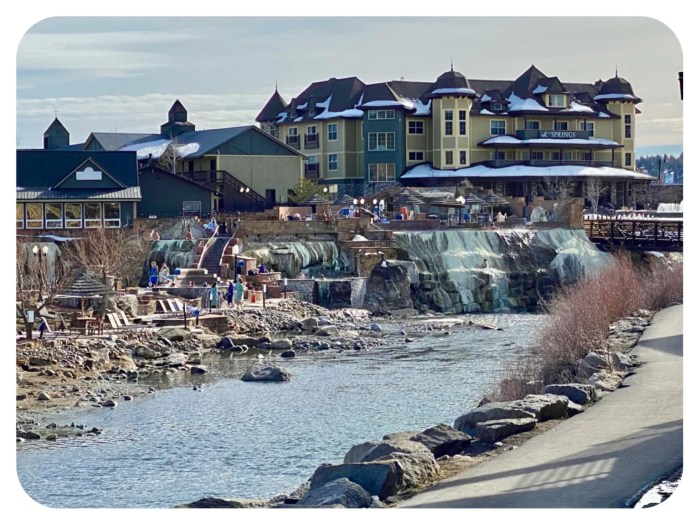
Planning a trip to a Colorado hot spring should include more than just the soaking experience. Knowing the practical details like accessibility, transportation, and cost is crucial for a smooth and enjoyable visit. This section will cover the practical considerations for each hot spring destination, helping you choose the perfect spot for your needs.
Accessibility Features
Many Colorado hot springs are committed to providing accessible experiences. Look for details on ramps, accessible restrooms, and pathways. Some springs offer specialized amenities for guests with mobility challenges, like wheelchair-accessible seating areas or lowered entry points. It’s always a good idea to check the specific accessibility features of each hot spring on their website or by contacting them directly.
Transportation Options
Transportation options vary depending on the location of the hot spring. Some are easily accessible by car, while others might require a short drive or shuttle service. Check the distance and directions to the hot spring from your accommodation, and look into parking options, as availability and fees can differ. Consider public transportation options or ride-sharing services, especially if you’re traveling with a group or prefer not to drive.
Parking, Lodging, and Nearby Restaurants
Parking availability and costs can vary significantly. Some hot springs have limited parking, so it’s wise to arrive early, especially during peak season. Research nearby lodging options to ensure you have a convenient place to stay, whether it’s a hotel, cabin, or vacation rental. Exploring nearby restaurants can enhance your trip, and many hot spring destinations offer local dining experiences within walking distance or a short drive.
Cost Considerations
Admission prices for hot springs vary. Prices often depend on factors such as the amenities offered, the size of the spring, and the popularity of the destination. Consider the cost of entrance, any additional activities, and potential spa treatments. Compare prices among different hot springs to find the best value for your needs.
Seasonal Variations
The experience at Colorado hot springs can change with the seasons. In the summer, the outdoor areas might be more crowded, while the winter offers a more tranquil experience, often with special winter packages. Check the specific operating hours and conditions for the time of year you’re planning to visit. For example, some springs may have reduced hours or special winter packages to take advantage of the seasonal ambiance.
Accessibility, Parking, and Lodging Summary
| Hot Spring | Accessibility | Parking | Nearby Lodging |
|---|---|---|---|
| Strawberry Park Hot Springs | Good, with ramps and accessible restrooms | Limited, arrive early | Hotels and vacation rentals within 10-15 minutes |
| Ouray Hot Springs | Moderate, some accessibility features available | Limited, designated accessible parking areas | Hotels and B&Bs in town |
| Glenwood Hot Springs | Excellent, multiple accessible entrances and restrooms | Abundant, with designated accessible parking | Variety of hotels, motels, and vacation rentals |
Note: This table is a sample and should be verified with the specific hot spring’s website for the most up-to-date information.
Visual Representation of Hot Springs: Best Hot Springs In Colorado
Colorado’s hot springs aren’t just about the therapeutic soak; they’re about immersing yourself in breathtaking landscapes. From the shimmering turquoise waters to the towering peaks surrounding them, these natural wonders offer a visual feast for the senses. The beauty extends beyond the springs themselves, encompassing the surrounding forests, meadows, and valleys.The visual appeal of Colorado’s hot springs is a key factor in their allure.
The unique geological formations, the vibrant colors of the mineral-rich water, and the stunning scenery create a truly unforgettable experience. Each spring possesses a distinct character, shaped by its environment and the natural elements that surround it.
Visual Characteristics of Top Hot Springs
The visual beauty of Colorado’s hot springs varies dramatically, reflecting the unique geological and environmental conditions of each location. The water’s color, clarity, and temperature significantly impact the overall aesthetic. The surrounding scenery, including forests, mountains, and meadows, also plays a crucial role in enhancing the visual experience.
- Strawberry Park Hot Springs: This spring boasts a tranquil ambiance, nestled amidst towering pines and meadows. The water, a rich, light brown hue from the minerals it holds, is exceptionally clear, allowing you to see the bottom of the spring. The surrounding landscape is characterized by the deep greens of the forest floor and the golden hues of the aspen trees during autumn.
The gentle sound of the nearby creek adds to the serene atmosphere.
- Ouray Hot Springs: Located in the breathtaking San Juan Mountains, Ouray Hot Springs showcases a striking visual spectacle. The mineral-rich water often appears a milky white or opaque beige. Surrounding this natural beauty are the towering peaks of the San Juan Mountains, their rocky faces showcasing various shades of gray and brown. The crisp, clear mountain air enhances the overall experience, while the nearby waterfalls create a vibrant symphony of sound.
- Pagosa Springs Resort: This resort offers a blend of natural beauty and modern amenities. The water, often a light, milky white, is clear and inviting. The surrounding landscape is characterized by the high-elevation desert landscape, the vibrant colors of the wildflowers, and the towering San Juan Mountains, which offer a panoramic view. The spring itself is often framed by unique geological formations and a lush riparian environment, offering a unique visual contrast.
Surrounding Landscapes
The surrounding landscapes significantly contribute to the overall visual appeal of Colorado’s hot springs. From towering mountain ranges to verdant forests, the scenery enhances the experience and offers opportunities for exploration beyond the hot springs themselves.
- Mountain Views: Many hot springs are situated in mountain valleys or foothills, offering breathtaking views of the surrounding peaks. The changing seasons further enhance the scenery, showcasing vibrant colors in the spring and autumn, and the crisp white of the winter landscape.
- Forest Environments: Many hot springs are nestled within lush forests, creating a tranquil and rejuvenating atmosphere. The towering trees, the dappled sunlight filtering through the canopy, and the sounds of nature create a peaceful escape.
- Meadows and Valleys: Some hot springs are situated in meadows and valleys, where the vibrant colors of wildflowers and the open spaces create a feeling of vastness and serenity. The gentle slopes and the abundant greenery add to the picturesque beauty.
Water Characteristics
The water at Colorado’s hot springs is a significant component of the visual appeal, with variations in color, clarity, and temperature contributing to the overall experience.
- Color Variations: The water’s color often depends on the mineral content. Some springs are clear and sparkling, while others have a milky white or light brown hue. The varying shades add depth and visual interest to the springs.
- Clarity: The clarity of the water can range from crystal clear to slightly cloudy. The mineral content influences the clarity, with some springs showcasing the bottom and surrounding landscape in stunning detail.
- Temperature: The temperature of the water can affect the visual experience. The steaming, vapor-filled air adds a dramatic element, especially when combined with the surrounding landscapes.
Visual Summary Table
| Hot Spring | Visual Description |
|---|---|
| Strawberry Park Hot Springs | Tranquil ambiance nestled in a pine forest, light brown, clear water, serene atmosphere. |
| Ouray Hot Springs | Striking visual spectacle in the San Juan Mountains, milky white or opaque beige water, surrounded by towering peaks. |
| Pagosa Springs Resort | Blend of natural beauty and modern amenities, light milky white water, high-elevation desert landscape, and vibrant colors of wildflowers. |
Closure
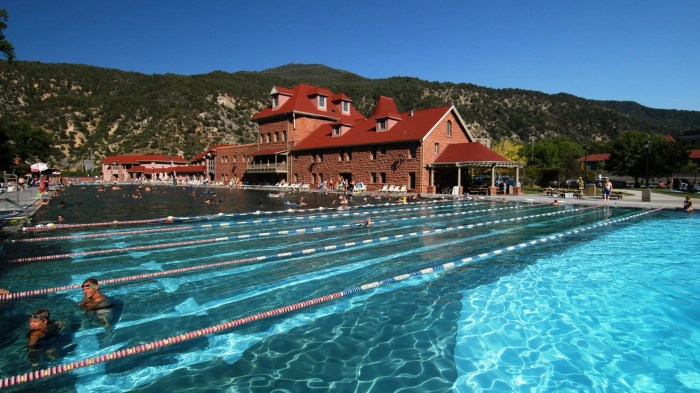
In conclusion, Colorado’s hot springs offer a diverse range of experiences for every type of traveler. From the rejuvenating waters to the breathtaking scenery, there’s a hot spring perfect for your next adventure. Whether you seek relaxation, rejuvenation, or a combination of both, this guide has provided a comprehensive overview of Colorado’s best hot springs. Enjoy the heat and the beauty!
